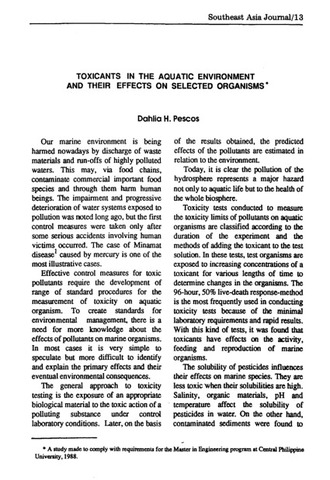Ipakita ang simpleng tala ng item
Toxicants in the aquatic environment and their effects on selected organisms
| dc.contributor.author | Pescos, Dahlia H. | |
| dc.date.accessioned | 2023-05-22T02:46:12Z | |
| dc.date.available | 2023-05-22T02:46:12Z | |
| dc.date.issued | 1989 | |
| dc.identifier.issn | 0038-3600 | |
| dc.identifier.uri | https://hdl.handle.net/20.500.12852/2686 | |
| dc.description | Journal article | en_US |
| dc.description.abstract | Our marine environment is being harmed nowadays by discharge of waste materials and run-offs of highly polluted waters. This may, via food chains, contaminate commercial important food species and through them harm human beings. The impairment and progressive deterioration of water systems exposed to pollution was noted long ago, but the first control measures were taken only after some serious accidents involving human victims occurred. The case of Minamat disease1 caused by mercury is one of the most illustrative cases. Effective control measures for toxic pollutants require the development of range of standard procedures for the measurement of toxicity on aquatic organism. To create standards for environmental management, there is a need for more knowledge about the effects of pollutants on marine organisms. In most cases it is very simple to speculate but more difficult to identify and explain the primary effects and their eventual environmental consequences. | en_US |
| dc.language.iso | en | en_US |
| dc.publisher | Central Philippine University | en_US |
| dc.subject.lcsh | Water--Pollution | en_US |
| dc.subject.lcsh | Poisons | en_US |
| dc.subject.lcsh | Toxicity testing | en_US |
| dc.subject.lcsh | Water--Pollution--Testing | en_US |
| dc.title | Toxicants in the aquatic environment and their effects on selected organisms | en_US |
| dc.type | Article | en_US |
| dcterms.accessRights | Publicly accessible | en_US |
| dc.citation.firstpage | 13 | en_US |
| dc.citation.lastpage | 14 | en_US |
| dc.citation.journaltitle | Southeast Asia Journal | en_US |
| dc.citation.volume | 17 | en_US |
| dc.citation.issue | 1 | en_US |
Mga file sa item na ito
Lumilitaw ang item na ito sa mga sumusunod na (mga) Koleksyon
-
Southeast Asia Journal [179]


